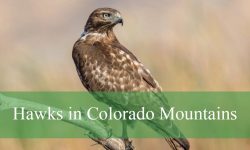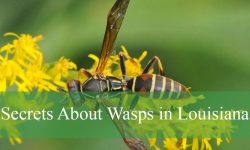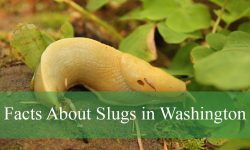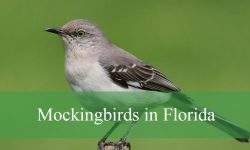Discover the rich and diverse birdlife of Oregon with our guide to 43 common birds. From forests to urban parks, these species are easily spotted.
Each bird includes detailed identification tips and vibrant pictures to help both beginners and experienced birdwatchers recognize Oregon’s feathered residents.
From coastal wetlands to backyard gardens, this comprehensive list will enhance your birdwatching experience in Oregon.
Most Common Birds in Found Oregon
American Robin
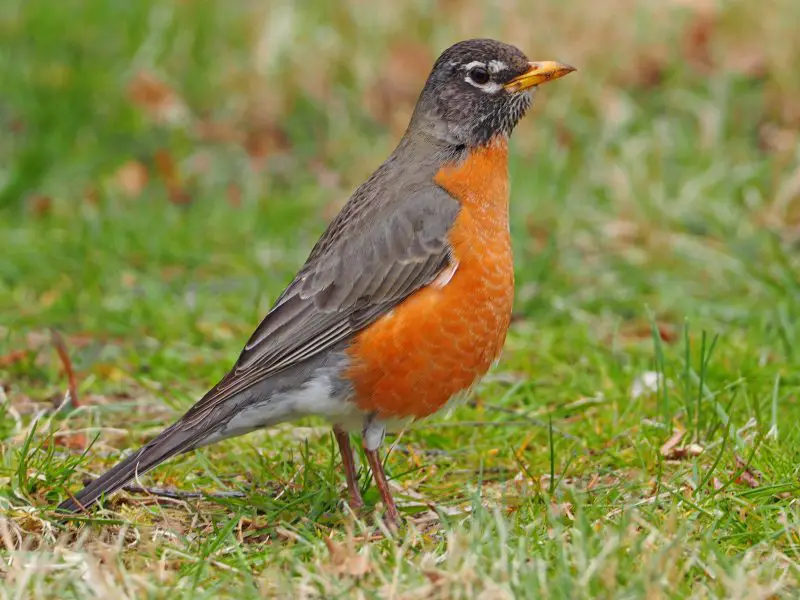
The American Robin is one of the most familiar and widespread birds in Oregon, known for its bright orange-red breast, dark gray back, and cheerful song. This medium-sized thrush has a rounded body, long legs, and a slender yellow bill. Its head is usually dark with a broken white eye ring that aids in identification. Juveniles appear speckled with a paler breast and mottled upperparts before acquiring adult plumage.
In terms of size, the American Robin typically measures around 9 to 11 inches in length with a wingspan of about 12 to 16 inches. Males tend to have slightly richer coloration than females, though both sexes share similar markings. Their flight pattern is swift and direct, often accompanied by a flicking motion of the tail. During the breeding season, males sing melodious phrases from high perches to defend their territories and attract mates.
These robins thrive in a variety of habitats across Oregon, including woodlands, suburban lawns, parks, and agricultural areas. They feed mainly on earthworms, insects, and berries, often foraging on the ground with quick hops. In winter, they form flocks that roam in search of fruit-bearing trees and shrubs. Their adaptability to both natural and human-altered landscapes has made them one of the state’s most recognizable and beloved birds.
Black-capped Chickadee
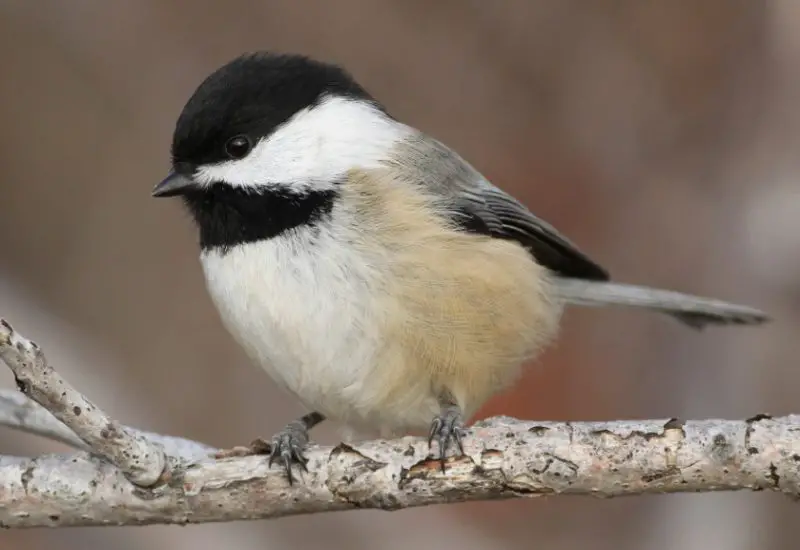
The Black-capped Chickadee is a small, active bird known for its distinctive black cap and bib, contrasting sharply with white cheeks. Its back is soft gray, and its underparts are buffy or light gray, giving it a delicate yet striking appearance. This species is highly recognizable by its namesake call, a cheerful “chick-a-dee-dee-dee” that varies in intensity depending on social interactions or alarm.
Measuring just 4.7 to 5.9 inches in length with a wingspan of 6 to 8 inches, the Black-capped Chickadee has a short neck, a proportionally large head, and a short bill. Despite its small size, it is hardy and resourceful, often found flitting through branches in search of seeds and insects. They are curious birds, frequently approaching humans and investigating feeders with confidence.
In Oregon, they inhabit mixed forests, wooded suburbs, riparian corridors, and parks. They are year-round residents, storing seeds and insects in hidden caches to survive cold winters. Their acrobatic foraging style allows them to glean insects from leaves and bark, and they often hang upside-down to reach food. These chickadees play a vital role in controlling insect populations and spreading seeds, making them an important part of Oregon’s ecosystems.
Northern Flicker

The Northern Flicker is a large, ground-feeding woodpecker that stands out due to its striking plumage and unusual habits. In Oregon, the western “red-shafted” form is most common, displaying a brown body patterned with black bars, a gray face, a red mustache stripe in males, and vivid salmon-red underwings and tail feathers. The breast is beige with black spots, and a prominent black crescent marks the upper chest.
This species measures 11 to 12 inches in length with a wingspan of 16 to 20 inches, making it one of the largest woodpeckers in the region. Unlike many woodpeckers, Northern Flickers often forage on the ground, probing soil for ants and beetles with their long, slightly curved bill. Their flight is undulating, and their loud “wick-a-wick-a-wick” calls, along with a piercing “kleeer,” make them easy to detect even at a distance.
Northern Flickers can be found in open woodlands, forest edges, orchards, and suburban areas across Oregon. They use both natural tree cavities and nest boxes for breeding. In winter, they supplement their insect diet with fruits and seeds. Their habit of hammering on metal objects during the breeding season serves as a territorial display and can often be heard in residential neighborhoods.
Song Sparrow
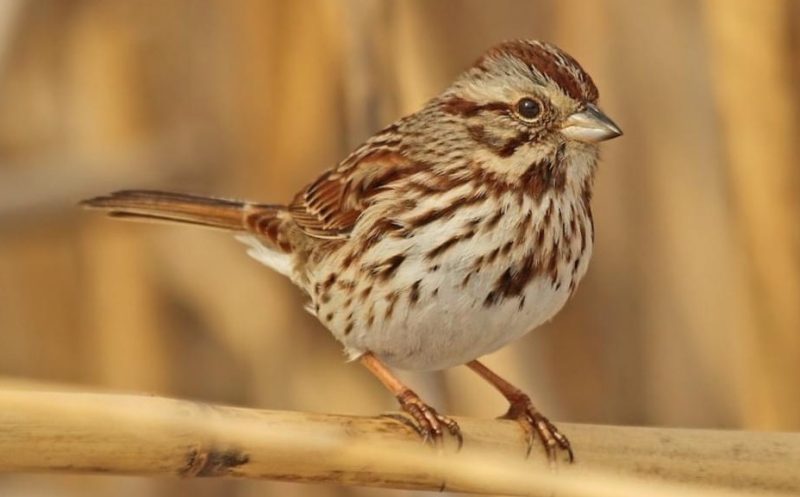
The Song Sparrow is a medium-sized, streaky brown bird that blends well into its surroundings yet reveals its identity through its distinctive, melodious song. Its brown upperparts are streaked with darker lines, while the white underparts are marked with bold brown streaks that converge into a central breast spot. The head often shows a grayish crown with a brown stripe, and a whitish eyebrow stripe enhances facial contrast.
Measuring 4.7 to 6.7 inches long with a wingspan of 7 to 9 inches, Song Sparrows vary slightly in color across Oregon due to regional differences. They are often seen perched on shrubs, fence lines, or low branches, delivering their rich, varied song to mark territory and attract mates. Their behavior is generally secretive, preferring to stay within dense vegetation, though they may venture into the open while foraging.
These sparrows occupy a wide range of habitats, from marshes and riparian thickets to residential gardens and agricultural fields. They feed primarily on seeds and insects, scratching at the ground or low vegetation to uncover food. In coastal and wetland areas of Oregon, Song Sparrows may remain year-round, while some inland populations migrate seasonally. Their adaptability and varied vocalizations have made them a familiar soundscape element across the state.
American Crow
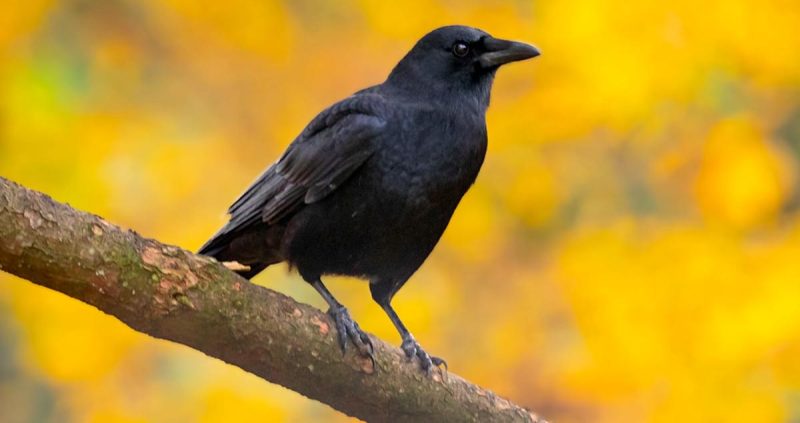
The American Crow is a large, all-black bird with a strong, stout bill and a wingspan of 33 to 39 inches. Its glossy feathers may show iridescent purple or blue highlights in good light. Known for its intelligence and adaptability, the American Crow is capable of problem-solving, tool use, and complex communication. Its loud “caw-caw” calls are among the most familiar sounds in both rural and urban Oregon.
At about 16 to 21 inches in length, the American Crow is a powerful flier with steady wingbeats and graceful glides. They are highly social birds, often seen in family groups or large communal roosts, especially during winter. Their diet is omnivorous, including insects, small animals, fruits, seeds, carrion, and human refuse, which makes them successful in a wide variety of environments.
In Oregon, American Crows inhabit forests, farmlands, cities, and coastal areas. They play an important ecological role as scavengers, helping to clean up dead animals and waste. Their adaptability to human presence has allowed them to thrive despite habitat changes. Observations have shown that crows can recognize individual human faces, remember interactions, and even teach these recognitions to other crows, further highlighting their remarkable intelligence.
Dark-eyed Junco
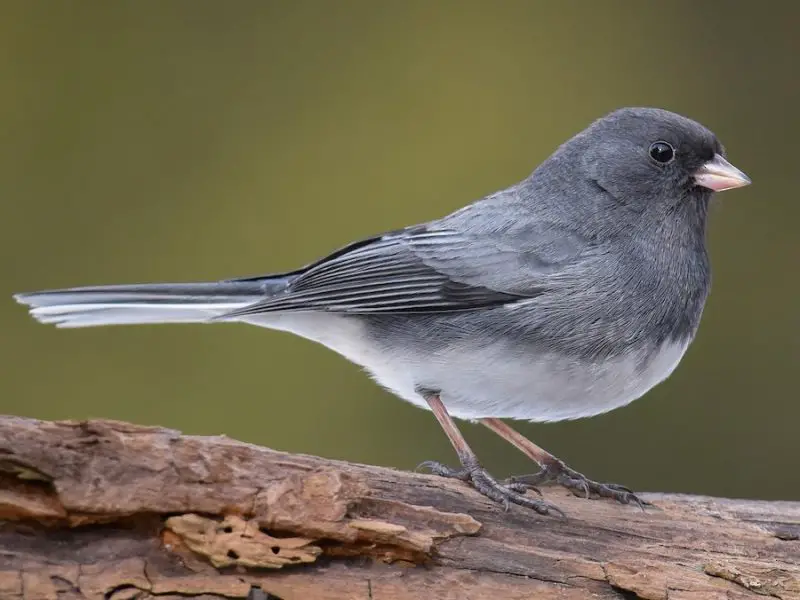
The Dark-eyed Junco is a small, ground-dwelling sparrow that is easily recognized by its crisp color patterns and flashing white outer tail feathers. In Oregon, the “Oregon” subspecies is most common, with a slate-gray head and chest, warm brown back, and pale pink bill. Its underparts are white, creating a sharp contrast with the darker upper body. Males often display more vivid coloration, while females appear softer in tone.
These birds measure about 5 to 6.5 inches in length with a wingspan of 7 to 10 inches. Their quick, darting movements and habit of hopping along the ground while foraging make them distinctive in behavior. Juncos primarily feed on seeds but will also take insects during the breeding season. Their call is a sharp “tik” or “chip,” and their song is a simple, trilling series of notes.
Dark-eyed Juncos inhabit forests, open woodlands, brushy clearings, and suburban yards throughout Oregon. In winter, they often form loose flocks that visit feeders, especially during snowy conditions. They prefer to forage under shrubs or trees, using cover to avoid predators. Their adaptability to both wild and human-altered habitats has made them one of the most common winter visitors in the state.
House Finch
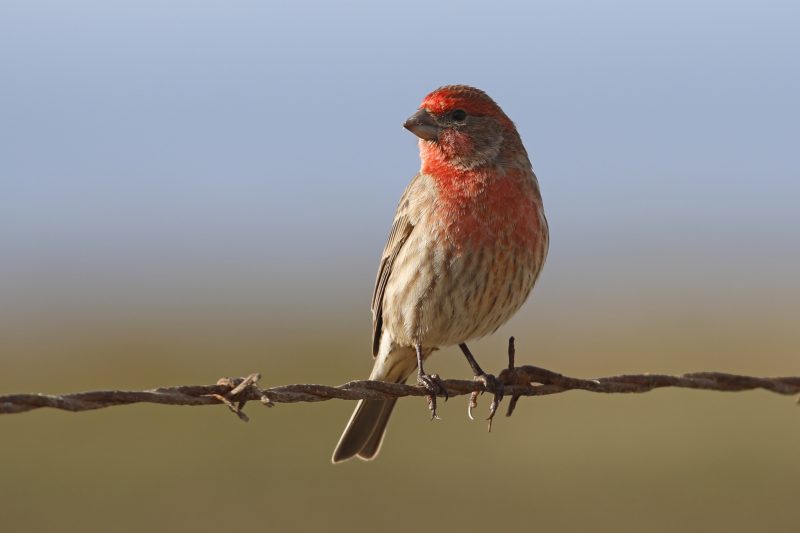
The House Finch is a small, sociable songbird known for its cheerful warbling song and colorful plumage in males. Males typically display red on the head, throat, and chest, fading into streaked brown sides and back. Females lack the red coloration, appearing in shades of streaky brown overall, which helps with camouflage. The species’ conical bill is well-suited for cracking seeds, their primary food source.
Measuring about 5 to 6 inches in length with a wingspan of 8 to 10 inches, House Finches are sturdy and active fliers. Their flight is bouncy, and they frequently perch in visible spots while singing. During courtship, males often feed females seeds, a behavior that helps strengthen pair bonds. They are highly adaptable and are found in both urban and rural settings.
In Oregon, House Finches thrive in backyards, parks, orchards, and open woodlands. They often visit bird feeders in large numbers, especially in winter. These birds are non-migratory, remaining in the state year-round, and they nest in a wide range of locations, from tree branches to building ledges. Their ability to live alongside humans has made them one of Oregon’s most familiar and abundant birds.
European Starling
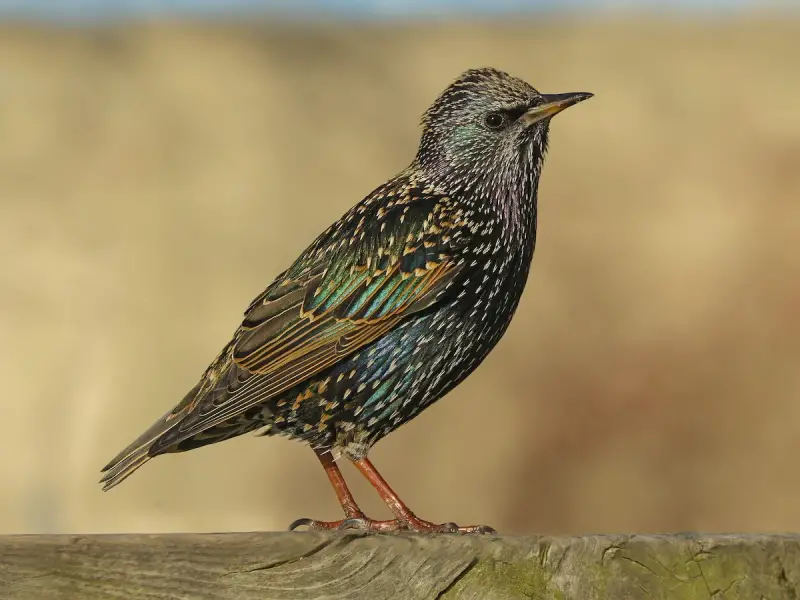
The European Starling is a stocky, medium-sized bird with striking iridescent plumage that shimmers with purple and green hues in sunlight. During the winter months, they are speckled with white spots, giving them a different appearance from their sleeker summer look. Their sharp, pointed bill changes color with the seasons, appearing yellow in summer and dark in winter.
They measure about 7.5 to 9 inches in length with a wingspan of 12 to 17 inches. Starlings are agile fliers with rapid wingbeats, often forming large, synchronized flocks known as murmurations. These aerial displays are breathtaking, with thousands of birds moving in fluid patterns. Their vocalizations are varied and mimic other bird species, making them skillful imitators.
In Oregon, European Starlings are found in cities, farmlands, grasslands, and open woodlands. Originally introduced from Europe, they have adapted well and now compete with native cavity-nesting birds for nesting sites. They feed on insects, fruits, grains, and food scraps, often foraging in open areas or visiting feeders. Their resourcefulness and adaptability have allowed them to become widespread across the state.
Anna’s Hummingbird
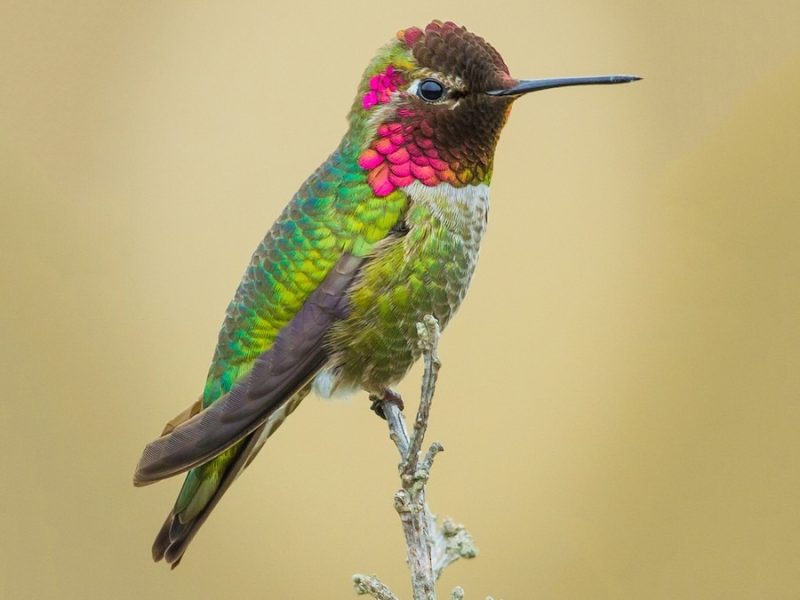
Anna’s Hummingbird is a small, vibrant species that is a year-round resident in much of western Oregon. Males are particularly striking, with an iridescent rose-pink throat and crown that gleam in the sunlight. Females have green upperparts, grayish underparts, and a small patch of pink on the throat. Both sexes have a slender, slightly down-curved bill designed for sipping nectar.
Measuring just 3.9 to 4.3 inches in length with a wingspan of about 4.7 inches, Anna’s Hummingbirds are capable of hovering in place, flying backward, and darting swiftly between flowers. They feed on nectar from a variety of plants, as well as small insects and spiders for protein. Males perform dramatic aerial courtship displays, diving from great heights and producing a sharp sound with their tail feathers.
These hummingbirds are commonly found in gardens, parks, coastal scrub, and open woodlands in Oregon. They readily visit feeders filled with sugar water, especially in winter when natural nectar sources are scarce. Their adaptability to urban environments and mild coastal climate has helped them expand their range northward in recent decades, making them a familiar sight even during colder months.
Mourning Dove

The Mourning Dove is a slender, graceful bird with soft gray-brown plumage, black spots on the wings, and a long, pointed tail edged in white. Its gentle appearance is matched by its mournful, cooing call, which is one of the most recognizable bird sounds in Oregon. The species’ small, dark eyes are surrounded by a thin ring of light blue skin, adding to its delicate look.
This dove measures about 9 to 13 inches in length with a wingspan of 17 to 18 inches. It is a strong flier with rapid, direct wingbeats, often producing a whistling sound in flight. Mourning Doves feed mainly on seeds, which they pick from the ground or from low vegetation. They can consume large amounts of seeds quickly, storing them in their crop before digesting them later.
In Oregon, Mourning Doves are found in open habitats such as fields, grasslands, deserts, and suburban areas. They are common visitors to backyard feeders, especially those offering millet and cracked corn. While some migrate south for the winter, many remain year-round in milder parts of the state. Their gentle demeanor and widespread presence make them a familiar and peaceful sight in both rural and urban landscapes.
Spotted Towhee
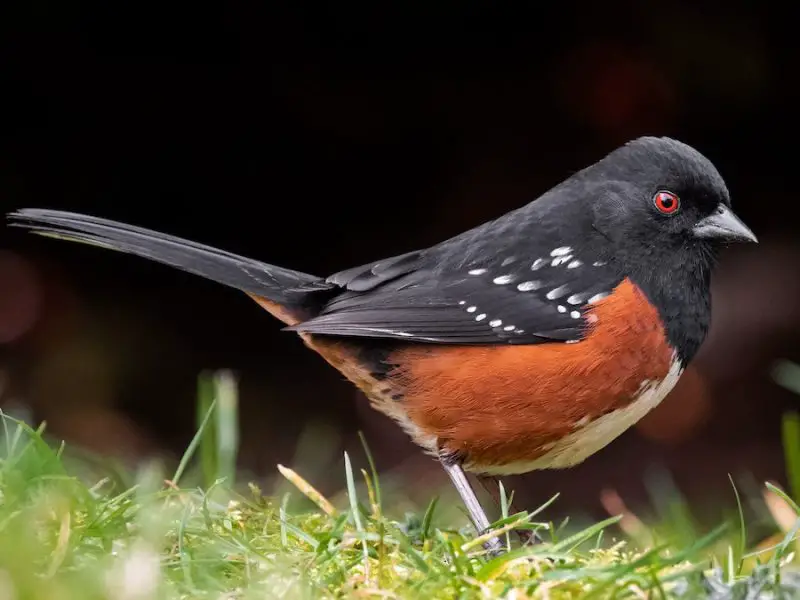
The Spotted Towhee is a striking and vocal songbird, easily identified by its bold black upperparts, bright rufous flanks, and white belly. Its wings and back are adorned with distinctive white spots, and its long tail is edged in white. Males have a deep black head, throat, and back, while females appear dark brown in these areas. Their eyes are a vivid red, creating a sharp contrast with the surrounding plumage.
Measuring about 6.7 to 8.3 inches in length with a wingspan of 11 inches, Spotted Towhees are robust, ground-foraging birds. They are often heard before they are seen, delivering sharp “chewink” or “tow-hee” calls. Their foraging style is distinctive, involving a double-scratch motion as they hop and kick through leaf litter in search of insects, seeds, and berries.
In Oregon, Spotted Towhees inhabit brushy edges, thickets, forest undergrowth, and suburban gardens. They prefer dense cover for nesting and protection from predators but will venture into open areas while feeding. Year-round residents in much of the state, they are especially common in mixed habitats that provide both shelter and open foraging grounds.
Barn Swallow
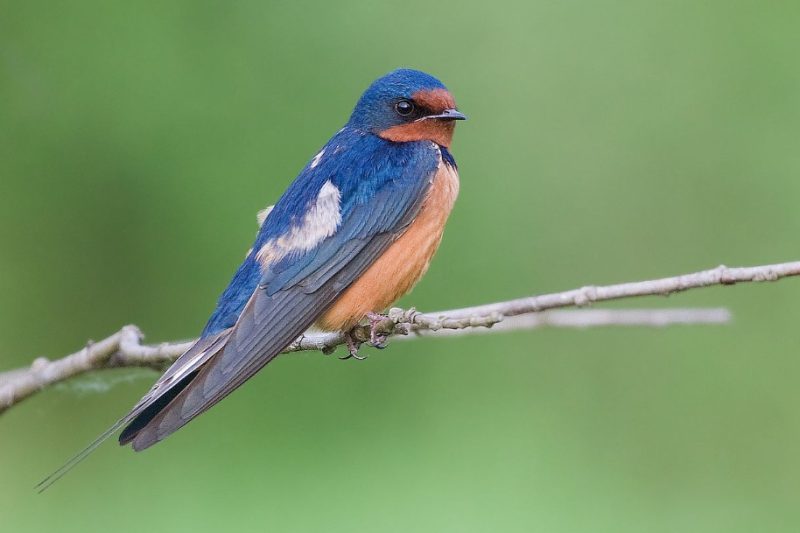
The Barn Swallow is a graceful aerial insectivore, recognized by its steel-blue upperparts, cinnamon underparts, and deeply forked tail. The forehead and throat are rich chestnut, while a blue band separates the throat from the pale belly. Its long, tapering wings and agile flight make it a superb hunter of flying insects.
Measuring about 5.9 to 7.5 inches in length with a wingspan of 11 to 12.6 inches, Barn Swallows are sleek and streamlined. They spend much of their time in flight, swooping low over fields, water, and open areas to catch prey. Their twittering calls and cheerful chirps often accompany their foraging flights, especially in breeding season.
In Oregon, Barn Swallows are common in rural areas, farmlands, wetlands, and near human structures. They build cup-shaped mud nests on beams, ledges, and rafters, often in barns or under bridges. These birds migrate to Central and South America for winter, returning in spring to raise their young in Oregon’s warm months.
Red-winged Blackbird
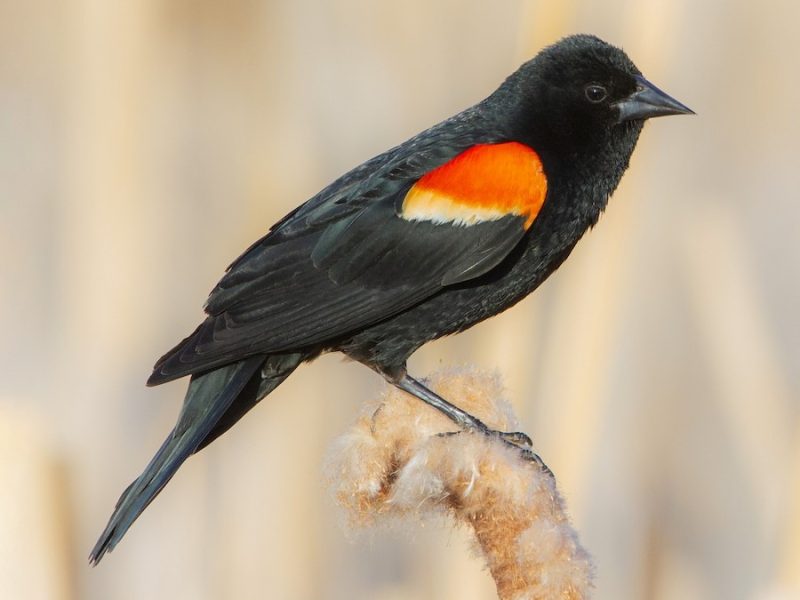
The Red-winged Blackbird is one of Oregon’s most familiar marshland birds, with males easily recognized by their glossy black plumage and striking red-and-yellow shoulder patches. Females are brown and heavily streaked, resembling large sparrows, which helps them blend into vegetation while nesting. Both sexes have sharp, pointed bills adapted for a varied diet.
These birds measure about 6.7 to 9.1 inches in length with a wingspan of 12 to 15.8 inches. Males sing a distinctive, buzzy “conk-la-ree” from prominent perches to defend territory and attract mates. They are often seen perched on cattails, fence posts, or shrubs, keeping watch over wetlands and fields.
In Oregon, Red-winged Blackbirds are abundant in marshes, wet meadows, and agricultural areas, but they also frequent roadside ditches and pastures. They forage for seeds and insects, often in large flocks outside the breeding season. During migration and winter, they may join mixed-species flocks with other blackbirds and starlings, creating spectacular gatherings.
American Goldfinch
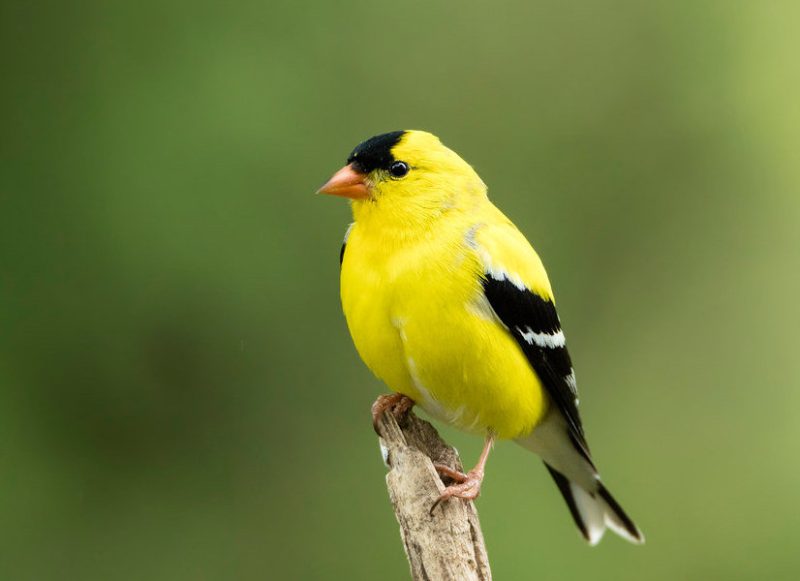
The American Goldfinch is a small, lively finch known for its vibrant summer plumage and undulating flight. Breeding males are a brilliant yellow with a black forehead, black wings with white markings, and a short, conical orange bill. Females and nonbreeding males are olive-yellow to brownish, providing camouflage in nonbreeding seasons.
Measuring about 4.3 to 5.1 inches in length with a wingspan of 7.5 to 8.7 inches, American Goldfinches are agile and often cling to seed heads while feeding. Their flight pattern features a series of bouncy arcs, often accompanied by a musical “per-chick-o-ree” call. Unlike many birds, they breed later in summer, timing nesting to coincide with peak seed availability.
In Oregon, American Goldfinches are found in open fields, weedy areas, gardens, and along roadsides. They feed primarily on seeds from plants such as thistles, sunflowers, and dandelions, occasionally visiting bird feeders stocked with nyjer seed. These finches are present year-round in much of the state, though northern populations may move south in harsh winters.
White-crowned Sparrow

The White-crowned Sparrow is an elegant songbird marked by bold black-and-white stripes on its head, pale gray face and underparts, and brown-streaked wings and back. Its pink or yellowish bill and clean facial markings make it easy to distinguish from similar species. Immature birds have brown and buff head stripes instead of black and white.
These sparrows measure about 5.9 to 6.3 inches in length with a wingspan of 8.3 to 9.4 inches. Their clear, whistled songs are often described as sweet and plaintive, varying among regional populations. They forage mostly on the ground, scratching through leaf litter for seeds and insects.
In Oregon, White-crowned Sparrows breed in open shrublands, meadows, and tundra-like habitats in the mountains, while many migrate through or winter in lowland fields and gardens. They are common visitors to backyard feeders, especially during migration. Their adaptability to different habitats and recognizable song make them a favorite among birdwatchers.
Western Scrub-Jay (California Scrub-Jay)

The Western Scrub-Jay, now recognized as the California Scrub-Jay, is a bold and intelligent bird easily identified by its vivid blue head, wings, and tail, contrasted with a gray-brown back and whitish underparts. A distinct blue necklace adorns the chest, and its strong, straight bill is well-suited for cracking seeds and nuts. These jays are known for their sharp, raspy calls, which often reveal their presence before they are seen.
Measuring about 11 to 12 inches in length with a wingspan of 15 inches, the California Scrub-Jay is an agile flier and adept forager. It often hops along the ground or through trees searching for acorns, insects, berries, and small animals. They are also notorious for caching food in scattered hiding spots to eat later, a behavior that showcases their remarkable memory.
In Oregon, they are most common in oak woodlands, chaparral, suburban neighborhoods, and parks, particularly in the western part of the state. Their adaptability to human-altered landscapes allows them to thrive alongside people, where they frequently visit backyard feeders. Their curious and sometimes mischievous behavior makes them a lively and entertaining bird to observe.
House Sparrow
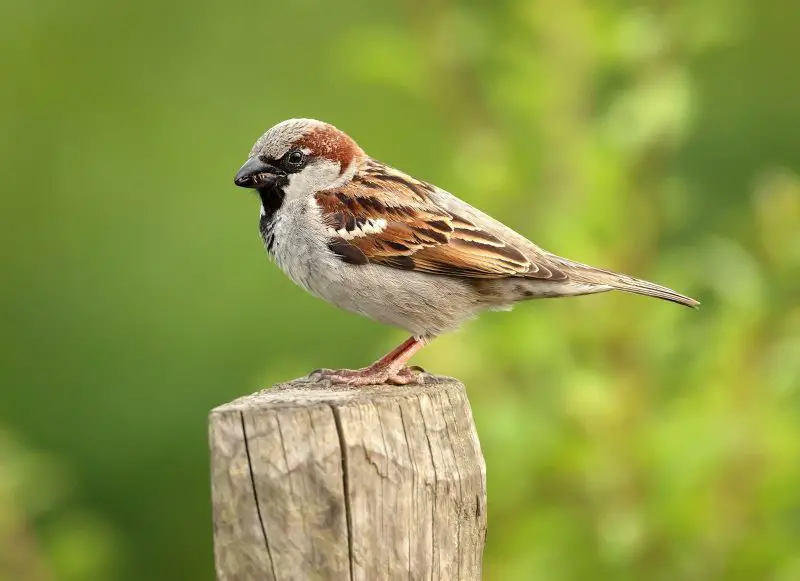
The House Sparrow is a stocky, adaptable songbird that has established itself as a common resident in cities, towns, and farms across Oregon. Males have a distinctive gray crown, chestnut nape, black throat, and streaked brown back, while females and young birds are more uniformly brown and buff, providing effective camouflage. Their short, stout bill is ideal for cracking seeds.
These sparrows measure about 5.9 to 6.7 inches in length with a wingspan of 7.5 to 9.8 inches. House Sparrows are social and often seen in noisy flocks, feeding on the ground or perching in shrubs and building ledges. They have a series of chirping calls and chatter, which they use to communicate within their groups.
Originally introduced from Europe, House Sparrows have adapted well to human environments in Oregon. They nest in cavities, crevices, and building structures, often in close proximity to people. Their diet includes seeds, grains, and scraps from human food, making them common around outdoor eating areas. Their resilience and opportunistic feeding habits have helped them become one of the most widespread bird species in the state.
Bushtit

The Bushtit is a tiny, sociable bird with a soft, fluffy appearance and an active nature. Its plumage is plain gray or brownish-gray overall, with a small head, short bill, and long, narrow tail. Males and females look alike, though females have pale eyes while males’ eyes are dark. Their high-pitched calls and constant movement make them easier to detect than to see clearly.
At just 3.5 to 4.3 inches long with a wingspan of about 5.9 inches, Bushtits are among the smallest songbirds in Oregon. They are highly active, often foraging in small, tight flocks that move quickly through shrubs and trees in search of insects, spiders, and small seeds. They build remarkable hanging, pouch-shaped nests woven from plant fibers, spider webs, and moss.
Bushtits inhabit woodlands, chaparral, suburban gardens, and riparian areas throughout Oregon, particularly in the west. They are year-round residents, providing constant activity and soft chatter to the landscape. Their cooperative flocking behavior in winter helps them locate food efficiently and provides safety in numbers.
Pine Siskin
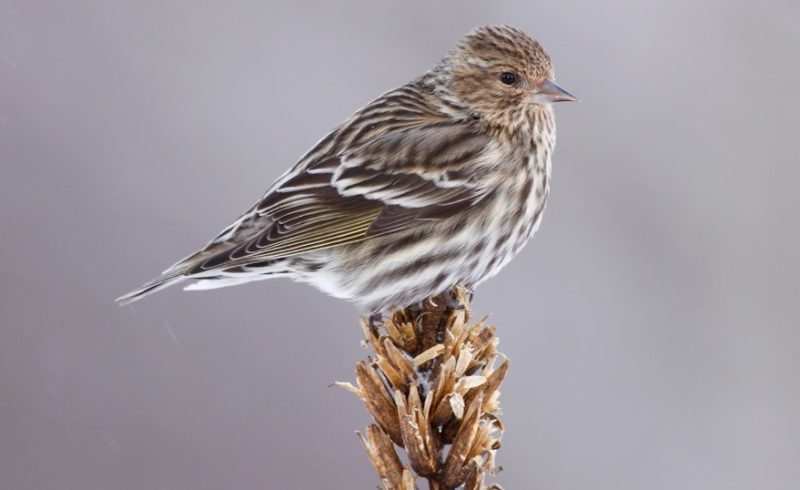
The Pine Siskin is a small finch distinguished by its streaky brown plumage and flashes of bright yellow in the wings and tail. It has a slender, pointed bill and a slightly notched tail, making it well-suited for extracting seeds from conifer cones. While their coloration is subtle, their constant activity and buzzy calls draw attention.
Measuring about 4.3 to 5.5 inches in length with a wingspan of 7.1 to 8.7 inches, Pine Siskins are agile and social, often forming flocks that forage in treetops or visit feeders. They feed on seeds from conifers, weeds, and flowers, as well as small insects. Their flight call is a distinctive rising “zzreeee,” which they use to keep contact with flock members.
In Oregon, Pine Siskins are found in coniferous forests, mixed woodlands, and backyard feeders, especially during irruption years when food shortages push them into more populated areas. They are present year-round in some regions but may migrate irregularly depending on seed availability. Their adaptability to various habitats and fondness for thistle seed make them frequent feeder visitors.
Downy Woodpecker
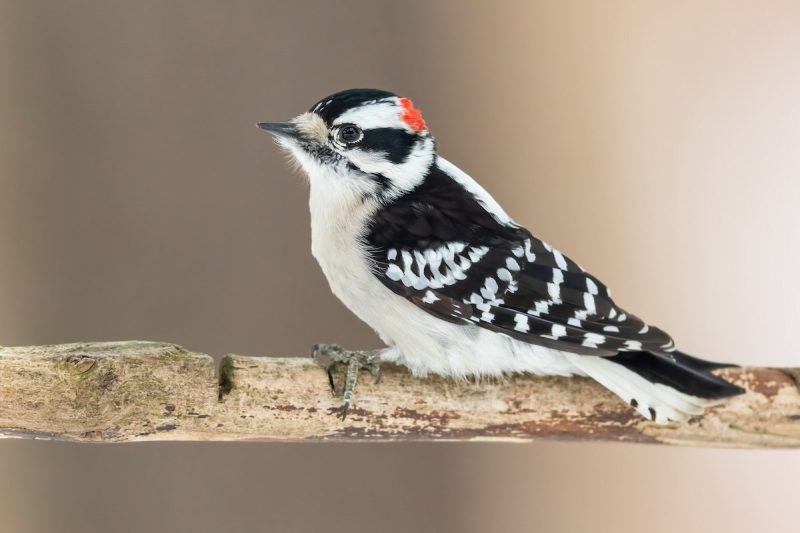
The Downy Woodpecker is the smallest woodpecker in North America and is common across Oregon. It has black-and-white plumage, with a white back, black wings patterned with white spots, and a white underside. Males have a small red patch on the back of the head, while females lack this marking. Its short bill is proportionally smaller than that of other woodpeckers, which helps in identification.
These woodpeckers measure about 5.5 to 6.7 inches in length with a wingspan of 9.8 to 11.8 inches. They move with an undulating flight and are often seen hitching up tree trunks or along branches in search of insects, larvae, and seeds. Their drumming on wood serves both as a form of communication and territory defense.
In Oregon, Downy Woodpeckers are found in forests, orchards, parks, and suburban yards. They readily visit feeders offering suet, sunflower seeds, and peanuts. Their adaptability and tolerance of human presence have made them a familiar sight throughout much of the state, where their gentle tapping is a common sound in wooded areas.
Steller’s Jay
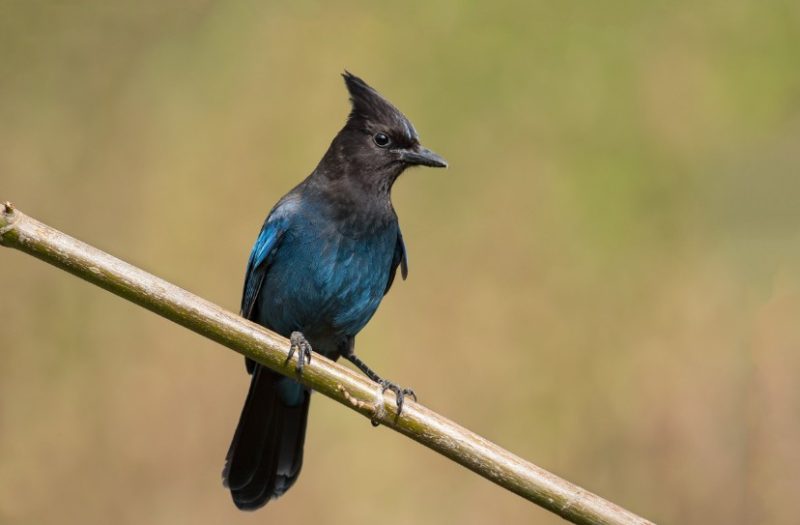
The Steller’s Jay is one of Oregon’s most striking birds, recognized by its vivid blue body and wings, contrasting sharply with a blackish head and upper body. A tall, expressive crest adds to its bold appearance, often raised when the bird is excited or curious. Its harsh, varied calls range from sharp squawks to complex imitations of other birds and even mechanical noises.
Measuring about 11 to 12.5 inches in length with a wingspan of 17 inches, Steller’s Jays are strong, agile fliers. They feed on a wide variety of foods including seeds, nuts, insects, berries, and occasionally small animals or eggs. Known for their curiosity and intelligence, they frequently visit campgrounds and picnic areas, boldly approaching humans for food.
In Oregon, Steller’s Jays are common in coniferous and mixed forests, particularly in mountainous and coastal regions. They are year-round residents and often cache food to retrieve later. Their bright colors and lively behavior make them a favorite among birdwatchers, and they often serve as a vivid reminder of the Pacific Northwest’s wild beauty.
Chestnut-backed Chickadee
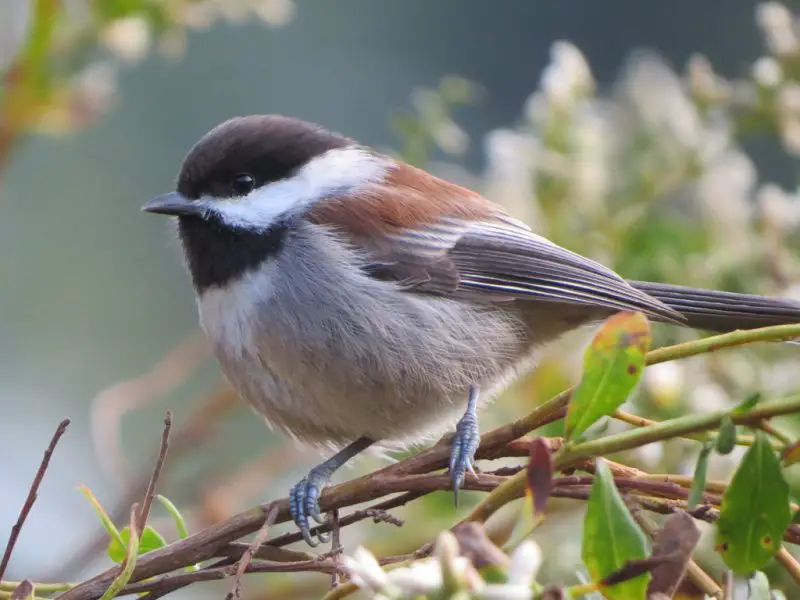
The Chestnut-backed Chickadee is a small, energetic songbird easily identified by its rich chestnut-brown back and sides, contrasting with a black cap, white cheeks, and gray wings. Its soft, high-pitched “chick-a-dee-dee” call is similar to other chickadees, but often delivered at a faster pace. This species’ warm-toned plumage sets it apart from its close relatives.
Measuring about 4.7 inches in length with a wingspan of 7 inches, the Chestnut-backed Chickadee is quick and active, often flitting through branches in search of insects, spiders, and seeds. They are especially fond of suet feeders, where they make repeated short visits to carry food away and store it.
In Oregon, they are most common in coastal forests, riparian woodlands, and moist coniferous areas, often sharing territory with other chickadee species. They are year-round residents, nesting in tree cavities or nest boxes. Their charming appearance and constant activity make them a welcome sight in forested areas and backyard feeders alike.
Cedar Waxwing
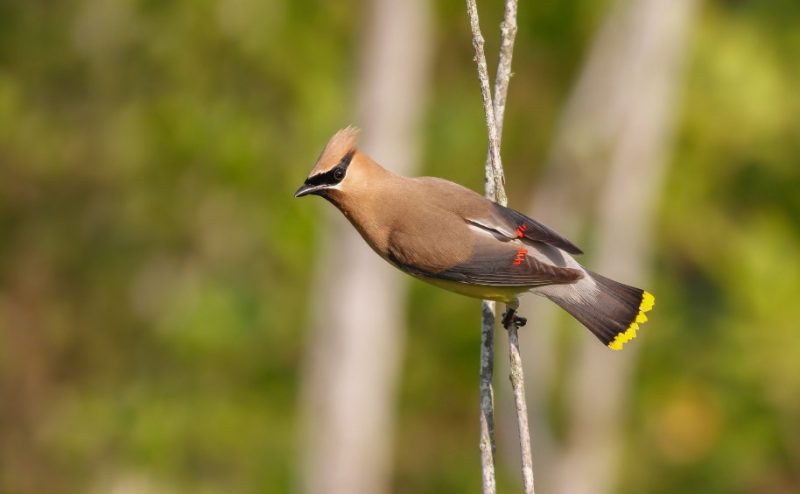
The Cedar Waxwing is a sleek, elegant bird with silky, pale brown plumage that fades into gray and then soft yellow on the belly. A prominent crest and a black mask bordered with white give it a distinguished look. The wings are tipped with small, wax-like red spots, and the tail is edged with bright yellow.
These birds measure about 6 to 7 inches in length with a wingspan of 8.7 to 11.8 inches. Cedar Waxwings are social and often move in flocks, feeding primarily on berries and fruits but also catching insects in midair. Their high-pitched, trilling calls are a signature sound of their presence, especially in summer and autumn.
In Oregon, Cedar Waxwings are found in woodlands, orchards, parks, and gardens, particularly where fruiting trees and shrubs are abundant. They are often seen perching in groups before descending to feed. Their role in spreading seeds makes them an important part of the ecosystem, and their graceful flight and refined appearance add elegance to any landscape.
Belted Kingfisher

The Belted Kingfisher is a medium-sized bird with a large head, shaggy crest, and long, thick bill designed for catching fish. Males are blue-gray above with a white underside and a single blue breast band, while females are more colorful, sporting an additional chestnut band across the belly. Their rattling call carries far over waterways.
Measuring about 11 to 14 inches in length with a wingspan of 19 to 23 inches, Belted Kingfishers are powerful fliers and skilled hunters. They perch patiently over water before plunging headfirst to catch fish, crustaceans, and aquatic insects. After capturing prey, they often beat it against a perch before swallowing it whole.
In Oregon, Belted Kingfishers are found along rivers, lakes, streams, and coastal areas year-round. They nest in burrows excavated into sandy or earthen banks, often near water. Their striking appearance, loud calls, and dramatic hunting dives make them one of the most distinctive water-associated birds in the state.
Tree Swallow
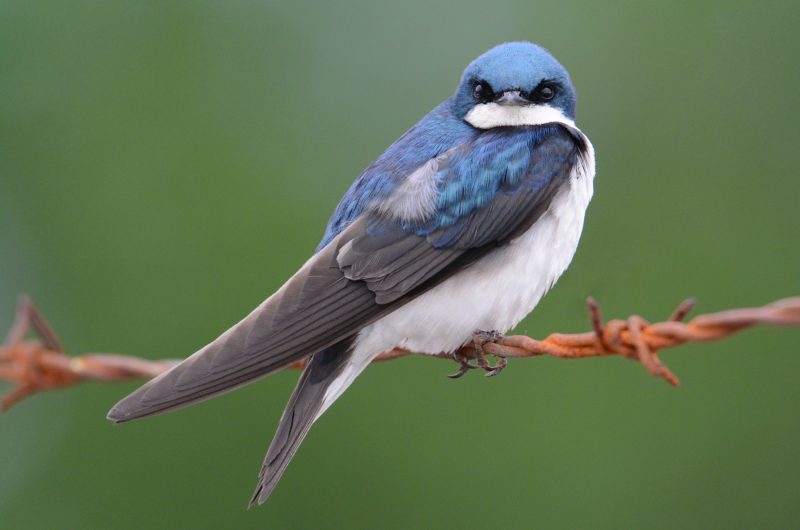
The Tree Swallow is a sleek, agile bird with shimmering blue-green upperparts and clean white underparts. Its small bill, long pointed wings, and slightly forked tail are well-adapted for catching insects in flight. Young birds are duller, with brownish upperparts before they acquire adult plumage.
Tree Swallows measure about 5.5 to 6.7 inches in length with a wingspan of 11.8 to 13.8 inches. They are highly skilled fliers, often seen swooping low over fields, wetlands, and water in search of flying insects. During the breeding season, they nest in tree cavities or nest boxes, lining them with feathers for insulation.
In Oregon, Tree Swallows are common in open habitats near water, including marshes, lakeshores, and grasslands. They are migratory, arriving in spring and departing in late summer or early fall for wintering grounds farther south. Their graceful aerial displays and iridescent plumage make them a favorite among birdwatchers each year.
Great Blue Heron

The Great Blue Heron is the largest heron in North America and a striking sight in Oregon’s wetlands and shorelines. It has a tall, slender frame with grayish-blue plumage, a long neck, and a sharp yellowish bill. A black stripe extends above the eye to a trailing plume, giving it a dignified appearance. In flight, its slow, deep wingbeats and tucked neck create a graceful silhouette.
Measuring about 38 to 54 inches in length with a wingspan of up to 79 inches, the Great Blue Heron is a patient and skilled hunter. It stands motionless in shallow water or along shorelines, waiting to spear fish, frogs, and other aquatic prey with a quick thrust of its bill. They also feed on small mammals, reptiles, and insects when available.
In Oregon, Great Blue Herons are found in wetlands, lakeshores, rivers, estuaries, and even suburban ponds. They are year-round residents in much of the state, nesting in tall trees near water in colonies known as rookeries. Their majestic presence and slow, deliberate movements make them a symbol of quiet persistence in Oregon’s waterways.
Killdeer
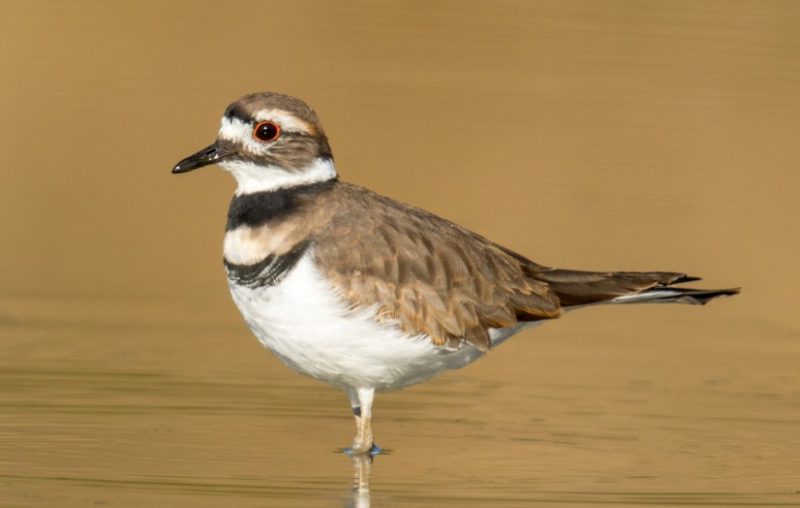
The Killdeer is a large, slender plover recognized by its brown upperparts, white belly, and two distinct black breast bands. It has a bright orange eye ring and a long, slender bill. Its loud, high-pitched “kill-deer” call is often heard before the bird is seen, especially in open habitats.
Measuring about 8 to 11 inches in length with a wingspan of 18 to 20 inches, Killdeer are agile runners that forage for insects and invertebrates on the ground. They are known for their dramatic “broken-wing” display, in which they feign injury to lure predators away from their nests or chicks. This behavior is one of the most recognizable in the bird world.
In Oregon, Killdeer are found in fields, shorelines, gravel roads, and even parking lots. They nest directly on the ground, often in exposed areas, relying on their camouflaged eggs to avoid detection. These adaptable birds are present year-round in many parts of the state, though some migrate south in winter from colder regions.
Rock Pigeon
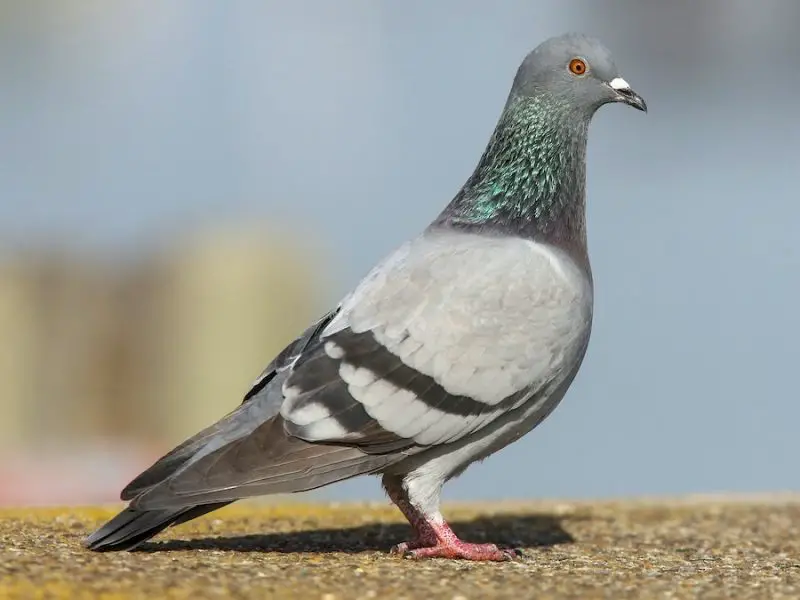
The Rock Pigeon, also known simply as the pigeon, is a familiar sight in Oregon’s cities, towns, and rural areas. Wild-type birds have bluish-gray plumage with two black wing bars and iridescent green and purple on the neck, though domestic and feral populations display a wide variety of colors and patterns. Their short legs and plump bodies make them instantly recognizable.
Measuring about 11 to 13 inches in length with a wingspan of 19 to 25 inches, Rock Pigeons are strong fliers capable of covering long distances. They feed mainly on seeds, grains, and scraps of human food, often foraging in flocks. Their soft cooing calls are a familiar sound in urban settings.
Originally native to Europe, North Africa, and South Asia, Rock Pigeons were introduced to North America centuries ago and have since thrived in human-altered landscapes. In Oregon, they are common in cities, agricultural areas, and coastal cliffs. Their adaptability and strong homing instincts have also made them important in human history, particularly as messenger birds.
Violet-green Swallow

The Violet-green Swallow is a graceful aerial insectivore with shimmering green upperparts and a violet sheen on the rump and tail. Its underparts are bright white, extending onto the sides of the rump and above the tail, a key feature that distinguishes it from similar swallows. It has a small bill, long pointed wings, and a slightly forked tail.
Measuring about 4.7 to 5.5 inches in length with a wingspan of 10.6 to 11.8 inches, this species spends most of its time in flight, catching insects over open areas, water, and forest edges. They are silent much of the time, but during the breeding season, they produce a series of cheerful, twittering calls.
In Oregon, Violet-green Swallows are common in open woodlands, river valleys, and mountain meadows. They nest in tree cavities, cliff crevices, or nest boxes, lining them with feathers for warmth. Migratory by nature, they arrive in spring to breed and depart by late summer for wintering grounds in Mexico and Central America.
Rufous Hummingbird
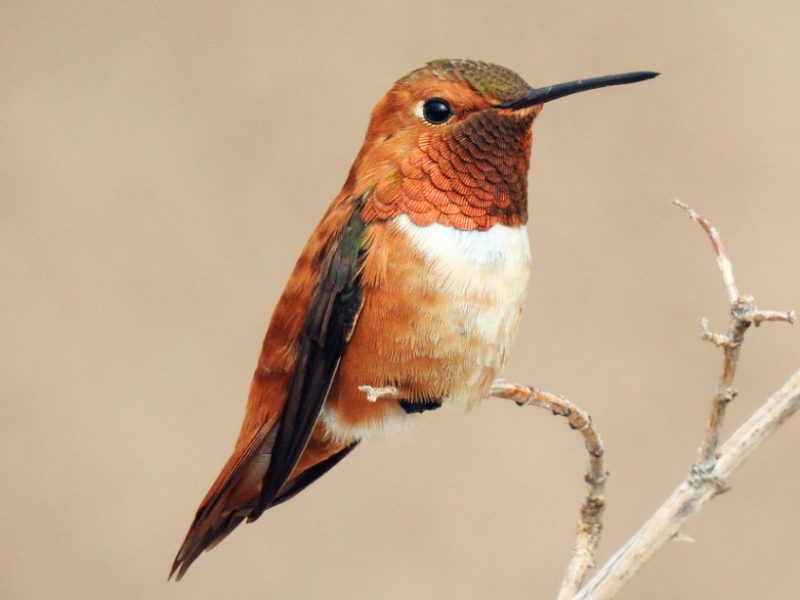
The Rufous Hummingbird is a small but feisty species known for its bright orange plumage in males and green-and-rufous coloration in females. Males have a gleaming orange-red throat (gorget) that glows brilliantly in sunlight, while females display green upperparts with rufous flanks and tail feathers. Their rapid wingbeats produce a characteristic humming sound.
Measuring about 2.8 to 3.5 inches in length with a wingspan of 4.3 inches, Rufous Hummingbirds are among the most aggressive hummingbirds, often chasing away larger species from feeders and flower patches. They feed on nectar from tubular flowers as well as small insects and spiders for protein. Their long migratory journey is remarkable, spanning from Mexico to as far north as Alaska.
In Oregon, Rufous Hummingbirds are common in gardens, forest edges, meadows, and mountainous areas during spring and summer. They are especially drawn to red and orange flowers, as well as sugar-water feeders. Their territorial nature and dazzling colors make them one of the most memorable hummingbirds to visit the Pacific Northwest.
Black-headed Grosbeak
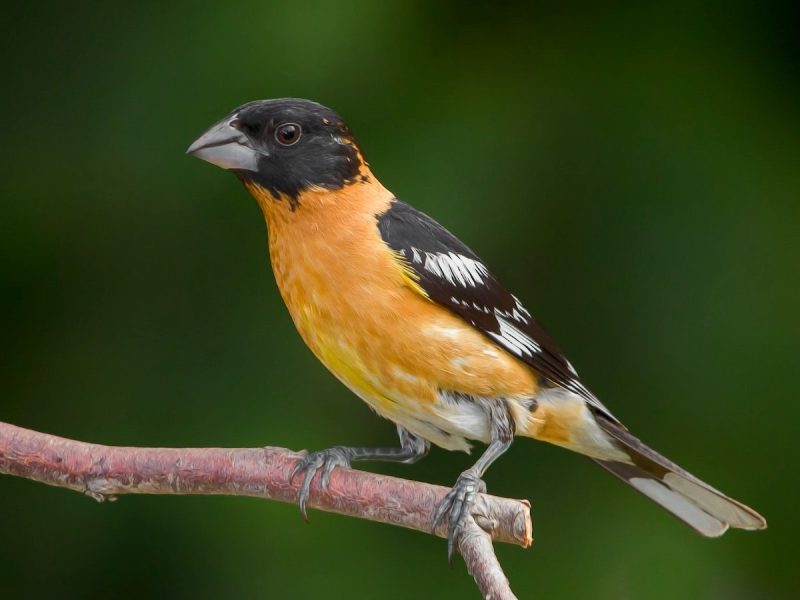
The Black-headed Grosbeak is a striking medium-sized songbird known for its bold coloration and melodious song. Males have a black head, bright orange-brown breast, and white patches on the wings, while females display more subdued brown tones with streaked underparts. Both sexes have a large, conical bill adapted for cracking seeds and a wingspan of about 12 inches. They are often heard before they are seen, as their song resembles a richer version of the American Robin’s tune.
In Oregon, Black-headed Grosbeaks are migratory visitors, arriving in spring to breed and departing by late summer. They inhabit mixed woodlands, forest edges, parks, and suburban gardens where trees provide shelter and food sources. Their diet includes seeds, insects, and fruits, and they are particularly known for their ability to safely eat monarch butterflies, which many other birds avoid.
During the breeding season, males sing persistently to defend territories and attract mates, while females take on most of the incubation duties. They build cup-shaped nests high in trees, usually well-hidden among foliage. These birds play an important role in controlling insect populations and dispersing seeds, making them a valuable part of Oregon’s bird community.
Purple Finch
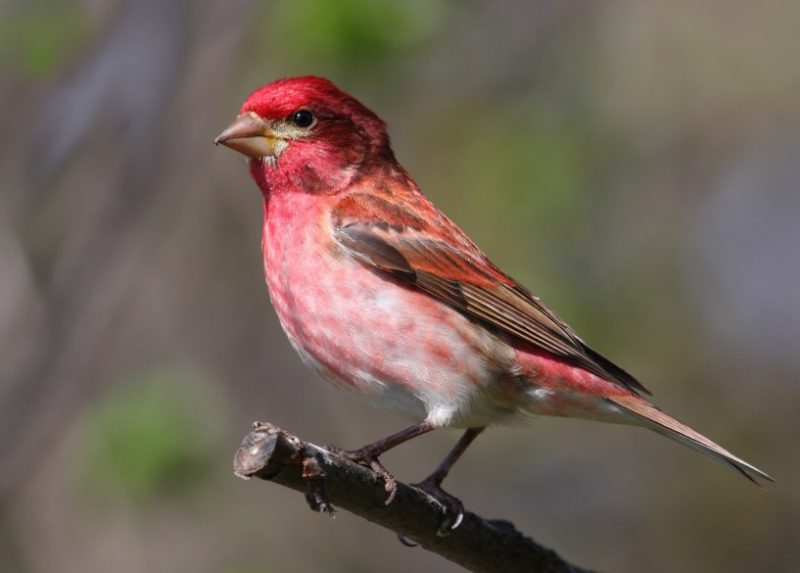
The Purple Finch is a small yet vibrant finch species recognized by its raspberry-red coloring in males and streaked brown plumage in females. Males have red on the head, breast, and back, blending into brown wings and tail, while females are heavily streaked with bold facial patterns. They measure about 6 inches long with a wingspan of 10 inches and have a stout beak suited for seed eating. Their song is a sweet, warbling melody often delivered from treetops.
In Oregon, Purple Finches are most commonly found in coniferous and mixed forests, though they also visit backyard feeders stocked with sunflower seeds. They are partial migrants, with some individuals staying year-round in western Oregon while others move south in winter. These birds feed on seeds, buds, berries, and insects, foraging both in trees and on the ground.
Purple Finches are known for their competitive nature around feeders, often displacing smaller finches. During courtship, males perform hopping and singing displays to impress females. Nesting typically occurs in conifers, with the female building a well-camouflaged cup-shaped nest. Their presence adds vibrant color and cheerful songs to Oregon’s birdlife.
Yellow-rumped Warbler
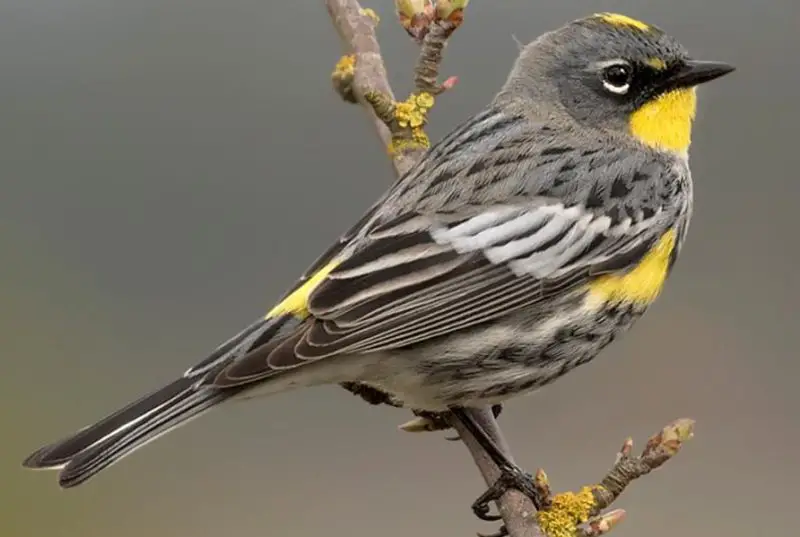
The Yellow-rumped Warbler is a small, active songbird easily recognized by the bright yellow patch on its rump, along with yellow flanks and a white throat. Breeding males have gray upperparts with black streaks, while females and nonbreeding males are duller but still show the signature yellow markings. They measure about 5.5 inches long with a wingspan of 9 inches, and their sharp “chip” calls are often heard as they forage.
This species is highly adaptable and can be found in Oregon’s coniferous forests, mixed woodlands, shrublands, and even urban areas during migration. They are unique among warblers for their ability to digest wax from bayberries and wax myrtles, allowing them to winter farther north than most warblers. Their diet also includes insects, spiders, and fruit, especially in colder months.
During migration and breeding, Yellow-rumped Warblers are often seen in mixed flocks, actively flitting through foliage in search of food. They nest in conifers, with females building small cup-shaped nests and incubating the eggs. Their adaptability and year-round presence in parts of Oregon make them one of the most commonly spotted warblers in the state.
Common Raven
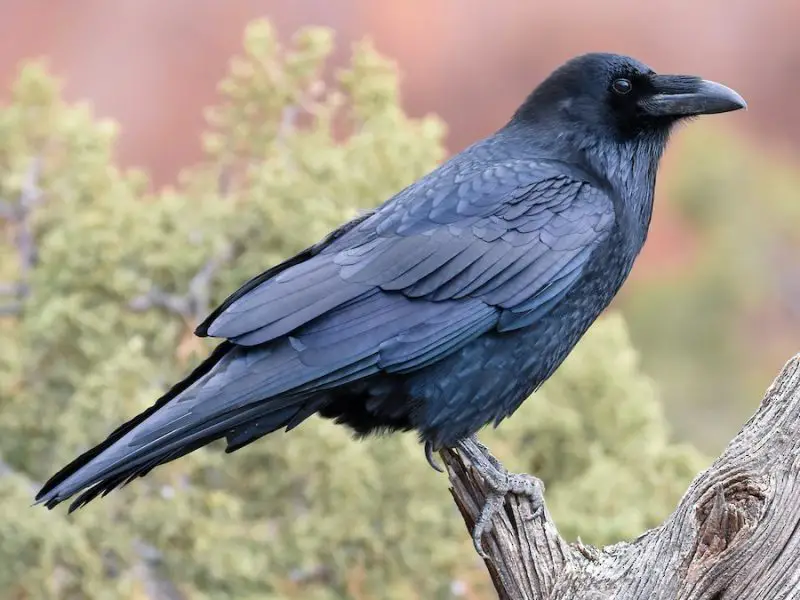
The Common Raven is one of the largest and most intelligent passerines, measuring up to 27 inches in length with a wingspan exceeding 45 inches. Its glossy black feathers have an iridescent sheen, and it is distinguished from crows by its larger size, heavier bill, wedge-shaped tail, and deep, resonant croak. Ravens are excellent fliers, often performing aerial acrobatics.
In Oregon, Common Ravens inhabit a wide range of environments, from coastal cliffs and forests to deserts and mountains. They are omnivorous, feeding on carrion, small animals, insects, grains, and human food scraps. Known for their problem-solving abilities, they have been observed using tools, playing games, and even mimicking sounds.
Ravens are territorial during breeding season but may gather in large flocks in winter. They build large stick nests in tall trees or on cliff ledges, reusing and adding to them year after year. Their presence in Oregon is a testament to their adaptability and intelligence, making them a fascinating species to observe.
Osprey
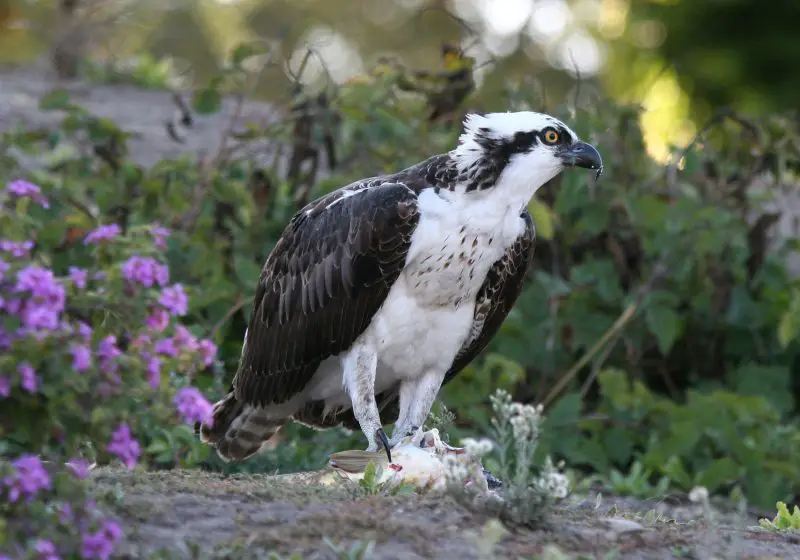
The Osprey, also known as the fish hawk, is a large raptor with a distinctive white head, dark eye stripe, and brown upperparts. Its wings are long and narrow with a characteristic crook, giving it a unique flight silhouette. Measuring about 23 inches in length with a wingspan of up to 71 inches, the Osprey is perfectly adapted for catching fish, with reversible outer toes and barbed pads on its feet.
Ospreys are common along Oregon’s rivers, lakes, reservoirs, and coastal areas during the breeding season. They are migratory, wintering in Central and South America before returning in spring. Their diet consists almost exclusively of fish, which they catch by diving feet-first into the water. They are skilled hunters, often hovering briefly before striking.
Nesting typically occurs on tall snags, utility poles, or man-made platforms, and pairs often return to the same nest site year after year. Ospreys are a conservation success story, having rebounded strongly after the ban on DDT pesticides. In Oregon, their summer presence is a welcome sight for birdwatchers, signaling healthy aquatic ecosystems.
Red-breasted Nuthatch
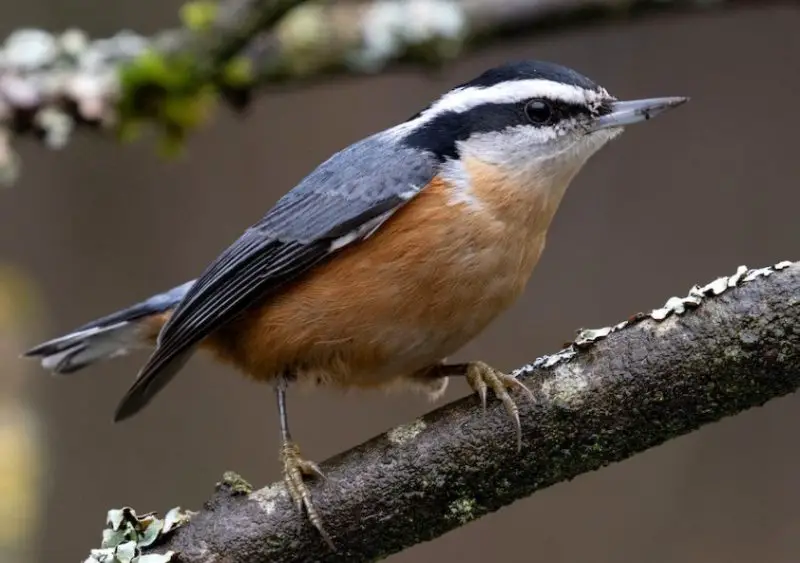
The Red-breasted Nuthatch is a small, active songbird known for its distinctive black-and-white facial pattern and rusty reddish underparts. Its slate-blue upperparts contrast with a bold black eye stripe and white supercilium above the eye. The short tail and slightly upturned bill help it cling to tree trunks and branches as it forages.
Measuring about 4.3 to 4.7 inches long with a wingspan of 7.5 to 8.7 inches, this nuthatch is highly agile, often creeping headfirst down tree trunks in search of insects and seeds. Its call is a nasal “yank-yank,” frequently heard in coniferous forests throughout Oregon. It stores seeds by wedging them into bark crevices, later hammering them open with its bill.
In Oregon, Red-breasted Nuthatches inhabit mature coniferous and mixed forests year-round. They adapt well to backyard feeders offering sunflower seeds and suet. Their presence in both lowland and mountainous forests makes them a common and beloved bird for birdwatchers, contributing to the health of forest ecosystems by controlling insect populations.
American Kestrel
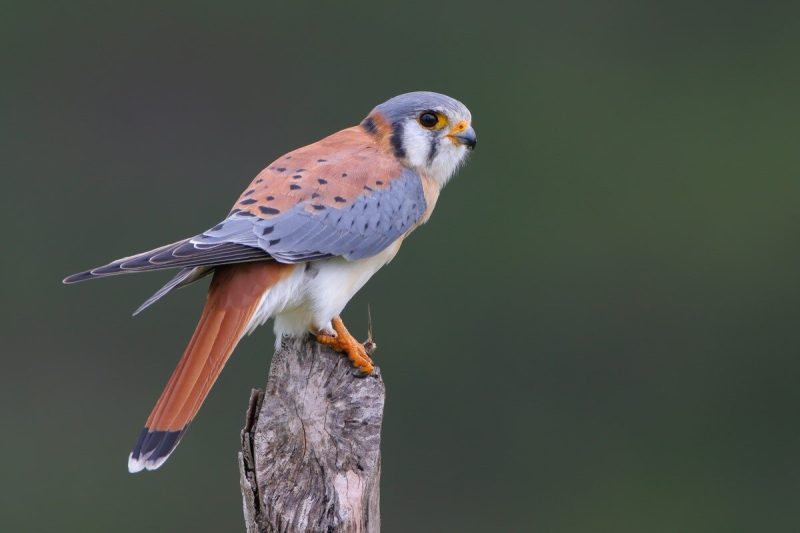
The American Kestrel is North America’s smallest falcon and a strikingly colorful raptor. Males display slate-blue wings with black spots, a rusty back and tail with a black terminal band, and a white face marked with vertical black facial stripes. Females are overall browner with similar facial markings. Both sexes have a hooked bill adapted for hunting small prey.
Measuring about 8 to 12 inches in length with a wingspan of 20 to 24 inches, American Kestrels are agile hunters that hover briefly while scanning open fields for insects, small mammals, and birds. Their rapid wingbeats and hovering behavior set them apart from other raptors in Oregon.
They occupy a range of habitats, including grasslands, farmland, open woodlands, and urban areas throughout Oregon. Nesting typically occurs in tree cavities, cliff crevices, or nest boxes. The species is a familiar sight perched on wires or poles, vigilantly watching for prey. Their adaptability and colorful plumage make them a favorite among raptor enthusiasts.
Brown Creeper
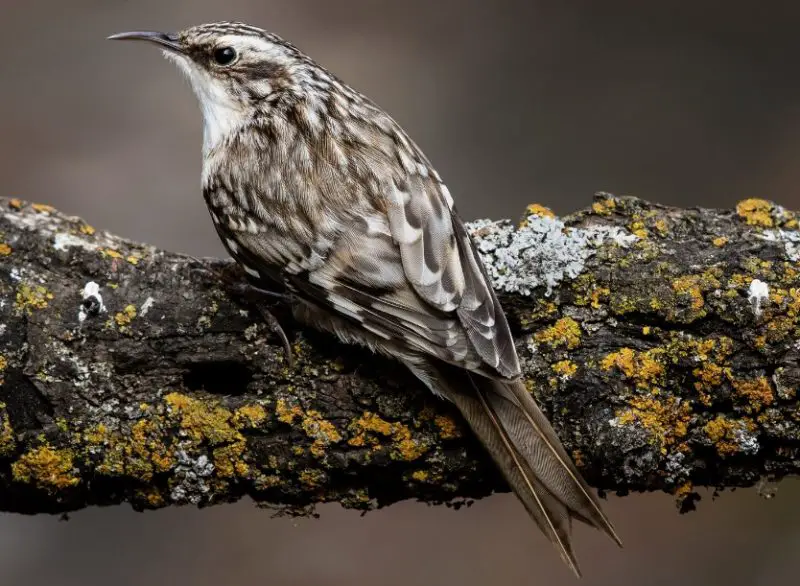
The Brown Creeper is a small, well-camouflaged bird with brown, streaked upperparts and a white underbelly. Its slender, down-curved bill is perfectly suited for probing bark crevices for insects and larvae. Brown Creepers move in a distinctive spiral pattern up tree trunks as they forage, often going unnoticed due to their cryptic coloration and quiet behavior.
Measuring about 5 inches in length with a wingspan of 8 to 9 inches, Brown Creepers are agile climbers that use their stiff tail feathers for support while climbing. Their soft, high-pitched calls are rarely heard except during the breeding season. They often join mixed-species flocks in winter to increase foraging efficiency and predator awareness.
In Oregon, Brown Creepers inhabit mature forests, particularly those with large, old trees providing ample bark surface for foraging. They are year-round residents but tend to be more secretive outside the breeding season. Their ecological role as insect predators helps maintain the health of forest trees.
Western Bluebird
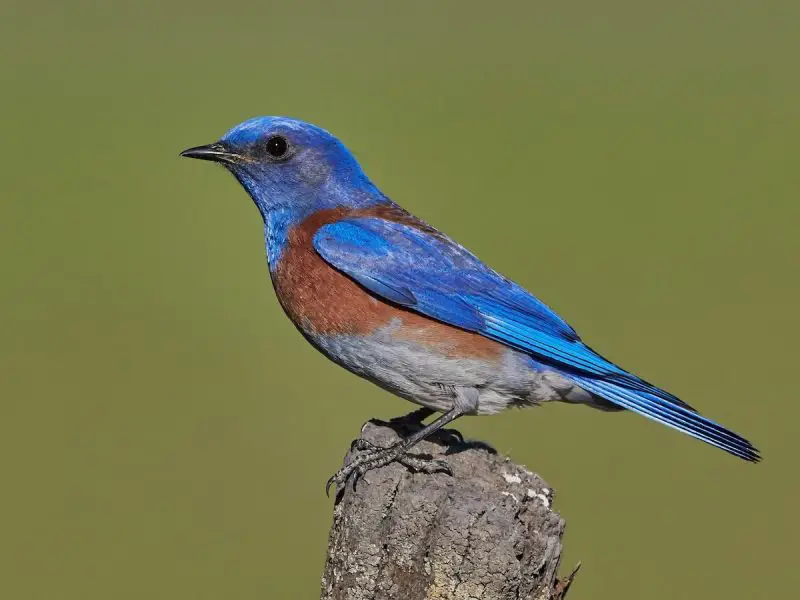
The Western Bluebird is a small thrush with vibrant blue upperparts and a rusty orange throat and chest. Females have a softer blue-gray coloration with paler underparts, while males display brighter and more vivid blues. Their slender bills and alert posture are well suited to their insectivorous and fruit-eating habits.
Measuring about 6.3 to 8.3 inches in length with a wingspan of 11 to 14 inches, Western Bluebirds are agile fliers, often seen perched conspicuously on fence posts or wires scanning for prey. Their song is a soft, warbling series of whistles, adding pleasant background music to open habitats.
In Oregon, they prefer open woodlands, orchards, fields, and suburban areas with scattered trees. They nest in natural cavities or nest boxes, making them common targets for conservation nesting projects. Their diet shifts seasonally from insects in summer to berries and fruits in winter, demonstrating adaptability to changing food availability.
Northern Harrier

The Northern Harrier is a medium-sized raptor known for its distinctive low, gliding flight over open fields and marshes. It has a slender body, long wings held in a shallow “V” shape, and a long tail. Males are gray above with white underparts and a striking facial disk reminiscent of an owl, aiding in sound localization. Females and juveniles are brown with streaked underparts.
Measuring about 17 to 20 inches in length with a wingspan of 40 to 46 inches, Northern Harriers hunt by flying low over grasslands and wetlands, using both sight and hearing to detect small mammals, birds, and insects. Their silent flight and keen senses make them efficient predators in open habitats.
In Oregon, they inhabit marshes, meadows, prairies, and agricultural fields year-round or seasonally. They nest on the ground in dense vegetation, relying on concealment to protect their young. Their role as controllers of rodent populations makes them an important component of healthy ecosystems in the state.
Bewick’s Wren
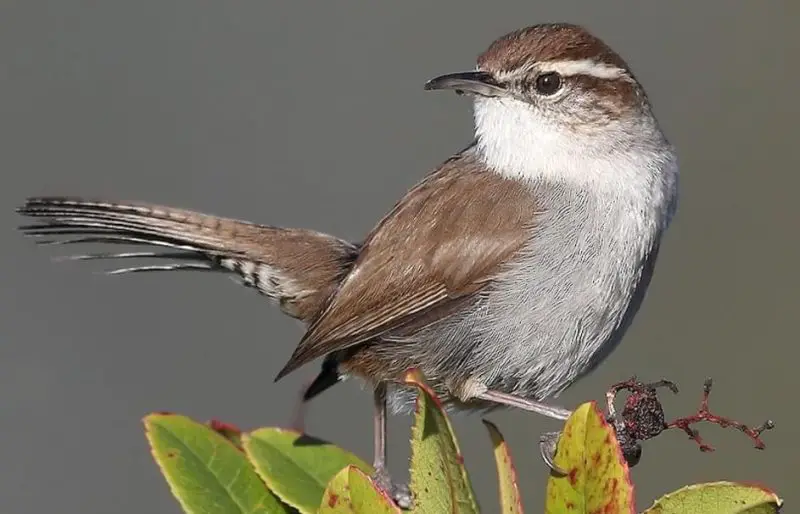
Bewick’s Wren is a small, energetic songbird with a long tail often held upright and boldly barred with white spots. Its plumage is warm brown on the upperparts and pale buff underneath, with a distinct white eyebrow stripe above dark eyes. Known for its loud and varied song, this wren’s vocalizations include rapid trills, whistles, and mimicry of other birds.
Measuring about 5.5 to 6.3 inches in length with a wingspan of approximately 8.7 to 10.2 inches, Bewick’s Wrens are active and agile, frequently hopping through shrubs, brush piles, and open woodlands in search of insects and spiders. They often nest in cavities or crevices in natural or human-made structures, using bark, leaves, and feathers to build their nests.
In Oregon, Bewick’s Wrens are common in dry brushy habitats, oak woodlands, suburban yards, and riparian zones, primarily in the western and southern parts of the state. They are year-round residents that adapt well to habitat changes and human presence. Their lively songs and energetic behavior make them a familiar and enjoyable presence in many Oregon landscapes.
Golden-crowned Sparrow
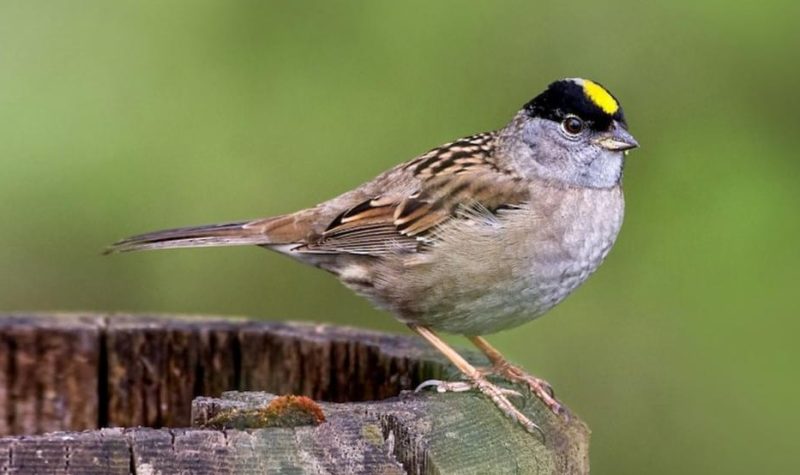
The Golden-crowned Sparrow is a medium-sized sparrow notable for the bright yellow patch on its crown, bordered by black stripes. Its face and breast are gray, while the back and wings are brown with streaking. The robust bill is pale pinkish, well adapted for seed-eating. Its sweet, musical trill is a signature sound during the winter months when the species is most visible.
Measuring about 6.3 to 7.1 inches in length with a wingspan of 9.1 to 10.6 inches, Golden-crowned Sparrows are ground foragers, feeding on seeds, berries, and insects in brushy areas and forest edges. They have a somewhat shy and secretive behavior, often seen skulking under dense shrubs or low vegetation.
In Oregon, Golden-crowned Sparrows are primarily winter visitors, arriving from northern breeding grounds in Alaska and Canada. They frequent coastal thickets, brushy fields, and gardens, often joining mixed-species flocks. Their presence signals the change of seasons, and their striking head markings make them a favorite for birdwatchers during colder months.
Hermit Thrush
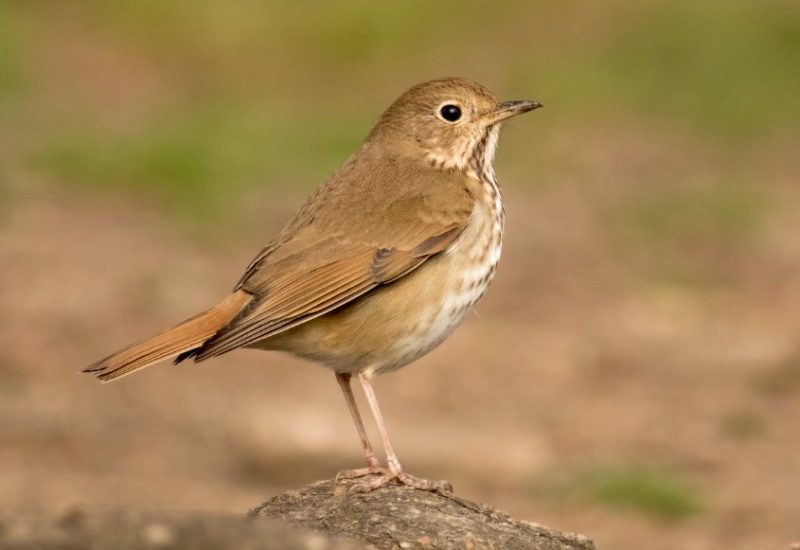
The Hermit Thrush is a medium-sized songbird with a warm brown back, reddish tail, and pale underparts adorned with distinct dark spots on the chest. Its delicate, flute-like song is hauntingly beautiful and often described as one of the most melodious in North American forests. A faint white eye ring and slender bill complete its modest but elegant appearance.
Measuring about 6.3 to 7.1 inches in length with a wingspan of 10.6 to 11.8 inches, Hermit Thrushes are mostly solitary and secretive, foraging quietly on the forest floor for insects, berries, and fruits. They move by hopping and occasionally flicking their tails upward, often in dense coniferous or mixed woodlands.
In Oregon, Hermit Thrushes breed in mountainous forests and dense woodlands, often at higher elevations. They migrate to lower elevation forests and shrublands in winter, sometimes visiting parks and suburban areas. Their ethereal song and shy behavior make encounters special moments for bird enthusiasts exploring Oregon’s wild landscapes.
FAQs About Common Birds in Oregon
What are some of the most common birds found in Oregon?
Oregon is home to a diverse range of bird species, including the American Robin, Black-capped Chickadee, Northern Flicker, Song Sparrow, and American Crow. These birds are frequently seen across various habitats such as forests, urban areas, wetlands, and grasslands throughout the state.
When is the best time to observe birds in Oregon?
Birdwatching in Oregon can be rewarding year-round, but spring and fall migrations are especially good times to see a wide variety of species. During these seasons, many migratory birds pass through or breed in the state, making it possible to spot both resident and transient species.
What habitats support the most bird diversity in Oregon?
Oregon’s varied landscape supports many bird species. Coastal areas and wetlands attract waterfowl and shorebirds, forests are home to woodpeckers and songbirds, grasslands host sparrows and raptors, and urban parks and gardens support species like House Sparrows and Steller’s Jays.
Are there any rare or endangered birds in Oregon?
Yes, Oregon is home to several rare and endangered bird species, including the Marbled Murrelet and the Western Snowy Plover. Conservation efforts focus on protecting their habitats and increasing awareness among the public to help preserve these vulnerable species.
How can I attract common birds to my backyard in Oregon?
Providing native plants, bird feeders with seeds such as sunflower and nyjer, fresh water sources, and shelter with trees or shrubs can attract many common Oregon birds. Planting berry-producing shrubs and avoiding pesticides also creates a bird-friendly environment.
Do any common Oregon birds migrate?
Yes, many common birds in Oregon are migratory. Species like the Barn Swallow, Rufous Hummingbird, and Violet-green Swallow migrate seasonally. Others, such as the Black-capped Chickadee and American Crow, tend to be year-round residents.
What is the difference between a crow and a raven, both found in Oregon?
While both are large, black birds, Common Ravens are generally larger with a wedge-shaped tail and a deeper, more resonant call. Crows are smaller, with fan-shaped tails and a higher-pitched caw. Ravens also exhibit more acrobatic flight patterns and are more solitary compared to the social crows.
Are there any birdwatching hotspots in Oregon?
Yes, some of the best birdwatching locations in Oregon include the Malheur National Wildlife Refuge, Oregon Coast, Smith Rock State Park, Klamath Basin, and the Willamette Valley. These areas offer diverse habitats and attract a variety of resident and migratory bird species.
What are common food sources for birds in Oregon?
Common birds in Oregon eat a variety of foods including seeds, berries, insects, small fish, and nectar. For example, hummingbirds feed on flower nectar, woodpeckers look for insects in tree bark, and sparrows and finches often eat seeds and grains.
How can I learn more about identifying Oregon’s birds?
Using field guides such as the “Sibley Guide to Birds,” bird identification apps like Merlin or Audubon Bird Guide, and joining local birdwatching groups can help improve bird identification skills. Visiting nature centers and attending guided bird walks are also great ways to learn.

